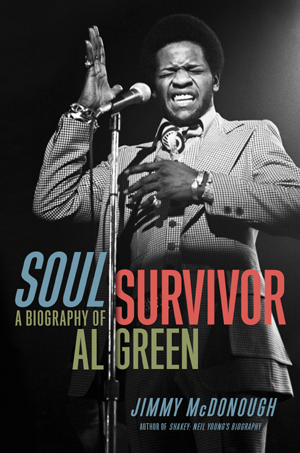AL GREEN

Soul Survivor
Book excerpt by Jimmy McDonough
(October 2017)
Here we hear about the details of Green's classic 1972 record Let's Stay Together
Let's Stay Together shows off a group of musicians at the top of their game. And it would only get better. "We've now gotten the sound I've wanted to hear since I got into music," Mitchell would say in 1973. This was one of those rare moments in pop culture history: the public was completely tuned into what Al Green and Hi Records were doing, and Green and Hi had a lot to give. "We were on a mission," said Charles Hodges. "I wanted Al's hit records as much as he did. We all wanted it bad. That's the reason we got 'em! Didn't nobody drag nobody down . . . you didn't have to hunt for nobody, everyone was there. What made it so good . . . we loved each other. And we were together. When we wasn't recording, we was together; when we was recording, we was together. Wasn't nothing fake about it."The atmosphere at Hi was different from that of Stax, or anywhere else. Willie Mitchell liked to tell the story of how they invited a bunch of street people in while they were cutting Let's Stay Together. "There's a bunch of winos out there," he told Robert Mugge. "So Al says, ‘Why don't you go and get four or five gallons of wine--let's bring these people in the studio.' So we brought about fifty people in here, all the winos, they're drinkin' wine, layin' on the floor while we were cutting the record . . . we'd all tell them to be quiet. If you'll notice on the Let's Stay Together album, you'll hear a lot of noise in the background . . . it's the winos."
Royal Studio was friendly, loose, open. The Hodges brothers palled around with players from local sports teams; they'd hang out and watch the sessions. At the center of it all was Willie, who remained remarkably accessible to people. "You could catch him every day at the studio," said songwriter Earl Randle. "People would ask, ‘How can I get in contact with Willie?' I said, ‘Go down to Hi and walk in.'"
It had been a long climb for Willie Mitchell. Since joining Hi in the early sixties, he'd fought to engineer his own records. Taught the band to play what he heard in his head. Happened onto such magical additions as Rhodes, Chalmers, Rhodes and--though he might've been loath to admit it--James Mitchell. Now that he'd unlocked Al Green, Willie had it all. "Once he got a hook on a song, it was hard to beat him. The song was dead," said Mitchell. "We had six years of nothing but gold and platinum records with Al."
Once the die was cast in the recording process, Mitchell changed nothing. He was particularly superstitious about the equipment (Green: "This man will not let you remove the cobwebs in the corner--‘No, no, no, don't touch that, it adds to the sound.'"), such as the RCA 77-DX ribbon mic reserved for Al's use. "It has a real romantic sound, a soft, warm sound," said Mitchell, who admitted the day he absently marked it number nine "I was drinking vodka." Willie stood by Royal's tube deck, even when everybody else had turned to transistors: "As long as Al records for Hi Records he'll always record on the eight-track." And he refused to deviate from that signature sound. Later on, when Denise LaSalle would report to him that "everybody's sayin' all your stuff sounds the same," Willie shot right back: "I will ride this horse until it falls dead."